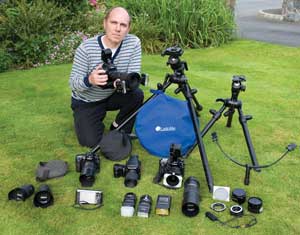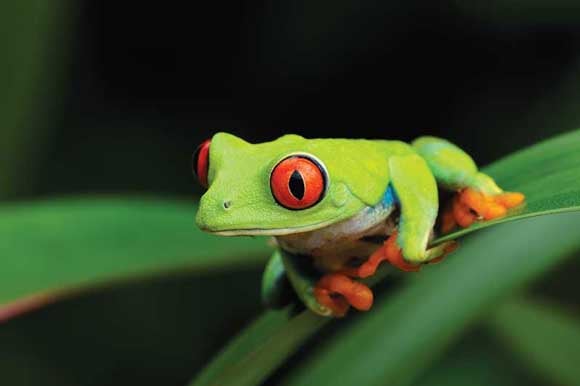Macro Photography – Macro photography equipment
![Mamiya 645]() Medium Format Benefits
Medium Format Benefits
Having decided to embark on a career as a natural history photographer, the next step for Robert was to equip himself with all the right kit – but where to start?
‘I upgraded my MX to a professional LX model, which I really liked for its 45° viewfinder. Given that I was spending quite a lot of time at ground level I found it a much more comfortable system to use,’ he explains.
However, even with his back-saving viewfinder attached, Robert soon came to realise the limitations of 35mm: ‘In terms of speed and portability 35mm worked well, but I found that if I wanted to show my subjects in relation to their habitat the actual subject became quite small, especially when trying to accommodate a good degree of background.
‘As a perfectionist I wanted the ultimate in quality so I decided to move to medium format. I found that medium format allowed me greater magnification of the subject while still retaining quite a lot of the background. For what I was doing at that point in time I found it ideal. It didn’t take me all that long to develop my own style and way of using the system to get the best out of it.’
Switching to Digital
Back in the 1990s before digital camera technology had evolved sufficiently, medium format was the obvious choice for Robert’s chosen specialisation. However, that all began to change a few years ago, as Robert explains: ‘Many natural history photographers were reluctant to use digital at the start, myself included. For me, the early cameras just didn’t offer the quality I was used to getting with medium format.
‘My first real breakthrough with digital was when I bought a Kodak Pro SLR/n – despite being prone to noise at higher ISO settings, it could produce excellent results if used correctly. It also had the Nikon mount offering access to a vast array of Nikon glass and close-up accessories. However, it was the launch of the Nikon D2X that really changed my opinion of digital technology. I felt that it was the first digital camera that proved a serious contender to film.
‘Currently, I own two D2X bodies and one D3. I still use both D2X cameras, but the D3 for me is even better – it’s phenomenal. It has certainly made a lot of my photography in some ways much easier – as it has for many photographers in other fields.’
And how exactly has the D3 made his work easier, we ask? ‘Well, although I’m primarily known for my macro work I also cover all aspects of natural history, and this means that I sometimes need to use high ISO speeds – not only does the D3 offer this, it also produces stunning results.
‘The D3 also works fantastically well with flash, which is very important because flash is such a major part of macro photography – something that is integral to maintaining consistency under difficult lighting conditions. In fact, it’s difficult to master macro photography without first mastering the use of flash – when to use it and how to use it,’ Robert explains matter of factly.
So, is Robert happy with the way digital has changed the photographic landscape, or does he still secretly long for the golden days of film? ‘Well, when digital finally caught on I found that most magazines no longer wanted transparencies, they wanted digital images, so digital has certainly revolutionised the photographic world in that respect,’ he laughs. ‘Perhaps it had gone a bit stagnant and in that respect digital has breathed new life into it. It has also opened photography up to a lot more people. The quality of amateur photography today is very high as a result,’ he opines.
 Know Your Equipment
Know Your Equipment
If you want to get serious about natural history photography then in addition to building up your specialist knowledge, Robert also advocates getting to know your equipment inside out:
‘For me, successful natural history photography is an amalgamation of two disciplines: first, your knowledge and skill as a naturalist and your ability to research subjects. And second, your technical ability with a camera. In my opinion the two are inextricably linked.
‘The choice of lens is important because it will affect the overall look of the image; if you’re using a longer focal length macro then you will get a better differential focus and the restricted angle of view is going to affect how the background vegetation looks, compared to using, say, a 50mm macro lens, which in the majority of cases just isn’t practical as you end up casting shadows over your subject or disturbing them.
With this in mind it’s hardly surprising that Robert’s lens of choice allows him to keep his distance when working: ‘I use a combination of equipment depending on the result that I want to get, or how close I feel I can get to the subject. I have a 200mm micro Nikkor lens, which I use probably about 70% of the time. It also has the advantage of having a tripod collar, which means I can rotate the camera into a vertical composition without having to lock the camera on its side – a big advantage in the field. Of course, it also gives me a greater working distance, which means I can stand well back from the subject and am less likely to disturb it.’
And is there an optimal time of day for taking natural history pictures? According to Robert, there is: ‘It is important to choose the right time of day. I prefer to work early mornings and evenings, because when it is cooler the temperature of the animals drops below the threshold for instant flight. You certainly won’t find me out chasing butterflies on a hot, sunny day, as they are ready for instant flight.’
Robert has authored several notable books including Close-up and Macro: A Photographer’s Guide (£13, ISBN: 0715319051). To buy a copy or to see more of Robert’s work, visit his website: www.robertthompsonphotography.com





